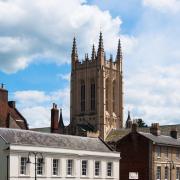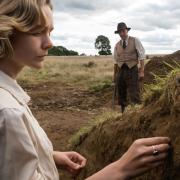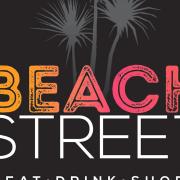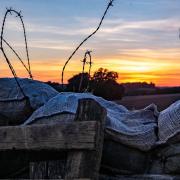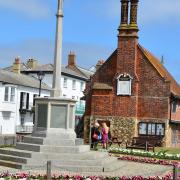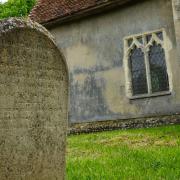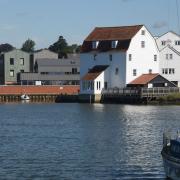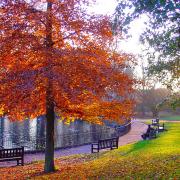Richard Bryson wonders why more residents don't sing the praises of a village gem - or is it a town? - in west Suffolk. He also goes for a wander in nearby Cavendish and Long Melford
Richard Bryson wonders why more residents don't sing the praises of a village gem - or is it a town? - in west Suffolk. He also goes for a wander in nearby Cavendish and Long Melford
It’s a strange sort of predicament. There I was in the rather lovely and unspoilt town of Clare trying to find people willing to say a good word about the place yet getting the nicest sort of brush-off.
“I’ve only just moved in – all the shops are taken you know – but probably best to talk to the people down the road,” says the friendly owner of Swan Antiques.
Off I go to an antiques centre across the street where a six foot model of a Roman soldier (�475) confronts me at the door. Again, obliging people inside but again, a slight reluctance to be quoted when someone else can speak with more authority on the subject.
I do get one good review though. “I would say there is a lot here for a large village…good pubs, a hotel, newsagent, a small supermarket, hair salons, cafes, banks, an excellent hardware store, art gallery, boutiques, estate agent, country park…” says one shop owner, who may still be listing what’s on offer now.
Next I meet a long-established Clare dweller and he is not so backward at coming forward. Except that he’s going to be a little critical and doesn’t want to be seen as a troublemaker.
His beef is with the planners who haven’t exactly added to the architectural lustre of Clare over recent decades.
He says too many residential buildings have replaced businesses in the town and there are new builds that have attempted to replicate a particular period – say Georgian – and then used cheaper materials so that the finished effect is lacking, and not as aesthetically pleasing. “It’s like they are saying ‘it’s just for one or two buildings, it doesn’t really matter’ but it does.”
I suspect he likes the place but, like many of us, doesn’t always see change as better. He looks back to a golden era, then forward to an uncertain future.
“Back in the seventies, and early eighties, we had auctions at the town hall as prestigious as those at Sothebys. Some incredible items were sold and the place was full of men in Gucci suits,” he says in hushed, respectful tones.
“We may lose the library and then there is the country park, if the council sell it off it won’t be well received.” Meanwhile in one street there is a sign declaring: ‘Stop Clare Wind Farm: Say No to BT.’ If there are dark clouds gathering at least I have the advantage of visiting on a sunny, early spring day. The light pastel shades of the houses (mainly pinks, creams and beige) make it a beautiful setting, the church of St Peter and St Pauls standing proud just off the market place.
The aforementioned, and possibly threatened, Clare Country Park is all lush pasture and trees gently swaying in a slight breeze. A labrador sniffs around a goods yard crane standing proud by an old station building. The Wise family, local farmers, saved one that was going to be scrapped at nearby Glemsford and donated it to the park.
Ducks are being fed on the ‘new cut’ river that passes around the remains of the castle, a small ruin on top of a mound, or motte. The 13th century stone castle keep overlooks the town and parts of the inner and outer baileys still exist. The park also contains the already mentioned (now decommissioned) railway station, the only one built within a castle in the UK.
It was constructed by the Great Eastern Railway and closed in 1967. The Stour Valley Path crosses the park. The Ancient House, overlooking the churchyard, is a Grade I Listed national importance. The West Wing, on the High Street, is believed to date from the 14th century.
It was given to the town in 1938 by Charles Byford, to be put to ‘a useful public purpose’ and in 1979, a museum was established here. It was entirely redesigned, and re-opened in 1999 but young visitors might prefer to know you can find a neolithic axehead and iron spearhead inside.
Before we end this little historical interlude I must also mention the town’s priory. It is one of the oldest religious houses in England and was the first house of the Austin (or Augustinian) Friars in England.
Following its suppression in 1538, the house passed through many hands and uses until the Augustinian Friars purchased the house in 1953 and returned to their origins in England.
Back to the present living, breathing Clare and I have, at last, found two representatives willing to sing its praises.
Another antique dealer says she moved to the area many years ago from Cornwall. Business could be better but they still get regular visitors who come back year after year.
She agrees the town is looking a picture and we remember the TV series Lovejoy and how it featured the village once or twice.
“It really put this area on the map but it also led to an increase in burglaries,” she says. Actually I rather like this pragmatic, ‘every silver lining has a cloud’ approach, it’s a very English characteristic in a very English place.
On the other hand you can bank on an estate agent to accentuate the positive in this corner of Suffolk.
Building, and is recognised as having Nicholas Mills of David Burr on the Market Hill says: “Clare is an extremely sought after address appealing to both young families and retirees due to its range of amenities. As well as the park, nine-hole golf course, and primary and middle schools it has more than 50 clubs and associations. It is also surrounded by some of Suffolk’s most photographed villages, including Cavendish.
“It is less than an hour and a half from central London and half an hour from Cambridge. Properties in the surrounding area range from �255,000 for a three bedroom 15th century cottage to The Old Vicarage in Stoke by Clare for �1,100,000. “ I later meet friends who tell me that to get a definitive take on Clare I should have sought out the owner of the hardware store. “Now he is a character,” they chorus.
It’s all rather charming, as is the not very vexed debate over whether Clare is a town or a village. Since Clare was voted Suffolk Village of the Year in 2010 I can’t see many residents asking for the award to be taken back.
Down the road and past the Atlanta Spa health spa, Cavendish can’t offer the amenities of Clare but it still has three pubs plus a tiny newsagent called The Duck or Grouse. It has an air of peace and tranquility.
A swanky looking new tearoom has opened recently by the village pond, except they don’t call it a pond it’s a waver. “A beautifully maintained duck pond with very few ducks,” is how one villager describes it.
Of course, the image that lingers is of the green set off by those famous pink cottages and the church behind. The Sue Ryder Charity was founded here in the 1950s.
We are in pargeting country here – several homes in the Stour Valley feature this raised plaster decoration on external walls. Horsehair and sand were mixed into a lime plaster which enabled the plasterer to fashion animals and heraldic images.
This was a rich part of the county and pargeting was a popular way to show off personal wealth in medieval times. More artistic and easier on the eye than satellite dishes.
On the road to Long Melford sits the Willow Tree Farm Shop, small, friendly and full of lovely local produce with fresh fish on Saturdays apparently. The Nethergate Brewery is nearby at the tiny settlement of Pentlow.
Further along the A1092 we reach Long Melford, a busy, working village at its heart but with interesting stately homes like Kentwell and Long Melford Hall on its edges.
With the River Stour close by there are some interesting valley walks too, you can even find a route through to Lavenham. Meanwhile the 15th century Holy Trinity Church on the green can’t and shouldn’t be missed. It’s as elegant inside as it is outside and it really is vast.
In Hall Street, the main artery of this village, there are crinkle-crankle walls and dozens of handsome old buildings some with newer frontages.There are tea-rooms, antique shops, galleries, boutiques, butchers and gift shops here as well as some very good places to eat.
It might just be the most complete village in the county – you can shop and sightsee as well as eat, drink and be merry in its convivial atmosphere.
Local planners can also point to some considered redevelopment. An old maltings at the Sudbury end of the village was tastefully converted into flats and dray houses in the late nineties. In keeping with this time of the Yuppie the rather rundown corner pub, a few yards away, suddenly became a wine bar called the Percy.
And did you know the parish includes the hamlets of Bridge Street and Cuckoo Tye? Now there’s an address to impress.



